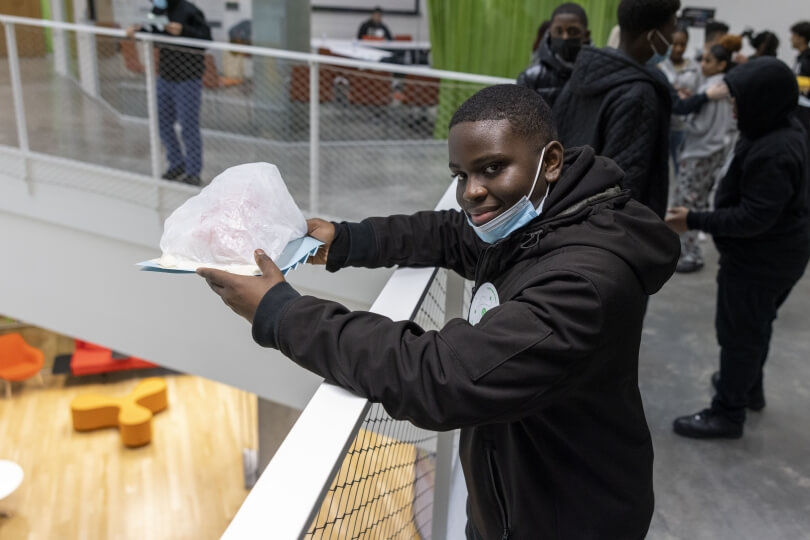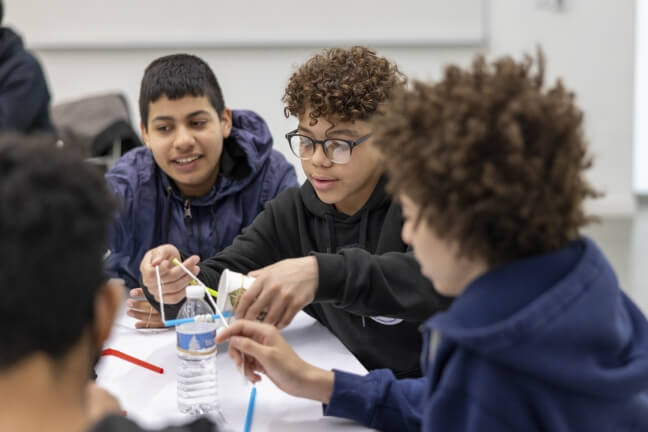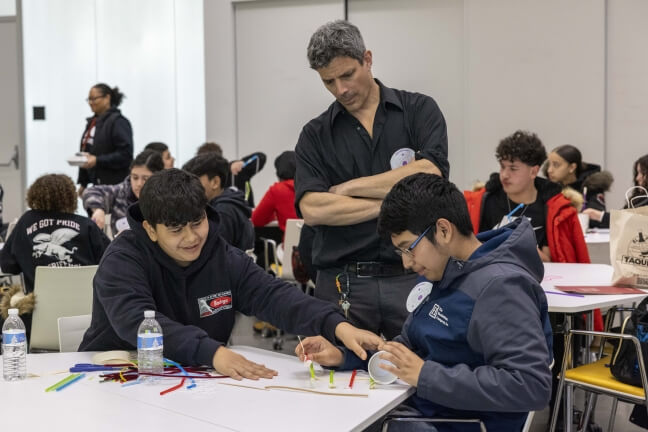A slice of science
Local eighth-graders experience SEC on Pi Day

By Matt Goisman
March 21, 2023
An eighth grader using plastic straws as the fingers of a robotic hand might one day build a gripper for use in a factory. A student constructing a landing module out of pipe cleaners and plastic cups someday might build one out of titanium at NASA. A student mechanizing a toothbrush with a simple motor and battery might someday design a robotic prosthetic limb.
Inspiring students to study and pursue careers in the fields of science, technology, engineering, and mathematics (STEM) was a key goal of Full STEAM Ahead on Pi Day. Eighth-grade students from four Boston Public Schools spent March 14 at the Science and Engineering Complex doing hands-on engineering projects and interacting with undergraduate and graduate students studying STEM at Harvard. The event was organized by Harvard John A. Paulson School of Engineering and Applied Sciences (SEAS) Director of Community Engagement and Diversity Outreach Kathryn Hollar and Education Outreach Programs Coordinator Sara Wenzel, and co-sponsored by the SEAS Office of Community Engagement and Diversity Outreach, Harvard Ed Portal Public School Partnership and Harvard Materials Research Science and Engineering Center.
"I hope we find a few engineers," said Sally Klimp, a project leader and executive advisor in the Keutsch Research Group at SEAS. "I hope we get a few people that really like thinking about how the world works, how things move, and product design."
Students from Mary Lyon School, Boston Green Academy, Brighton High School, and Gardner Pilot Academy were divided into four hands-on activities. In Klimp's activity, students used arts and crafts to build a lander capable of keeping two marshmallows in a plastic cup as it descended from the third to second floor of the SEC. Students also applied motors to the bristles of a toothbrush, built a robotic gripper out of cups, straws and string, and learned how to program an artificial intelligence algorithm to classify feedback as positive or negative.
"STEM and engineering provide great life lessons," said Loyd Joseph, who co-ran the BristleBot activity. "There was a kid earlier today who was frustrated because he couldn't make the project work. He wanted to give up, but engineering gives you the ability to fail, learn from that failure, and try again. He tried again, and his robot moved faster than all the others."
Applied physics postdoctoral student Jean Carlos Serrano Flores and materials science Ph.D. candidate Sofia Edgar ran the BristleBot challenge in Spanish for students who are not yet proficient in English.
Encouraging STEM participation in students from underrepresented minorities was another central goal of the Pi Day event. Paula Nicole Brooke, SEAS Assistant Dean for Diversity, Inclusion, and Belonging, helped introduce the event, which concluded with a panel of undergraduate students who spoke about their own collegiate experiences.
"This event highlights the types of experiences students need that help shape their college and career thinking," said Cyntoria Grant from the Harvard Ed Portal Public Schools Partnership. "The earlier the conversation, the more access to these opportunities on higher education campuses, the better their chances are to envision themselves going to college."


At the concluding college and career panel, several students discussed the challenges of being a minority student pursuing a STEM education.
"Before we started our STEM projects during Black History Month, we had them take a survey," said Betty Fenelon, a teacher at Gardner Pilot Academy. "Over 70 percent of them said they don't have family members in the STEM fields, so it's very important for them to be exposed and see people, even if they're not family, who look like them and they can relate to."
Following opening remarks from SEAS staff members, keynote speaker Wynter Dunanson addressed the crowd. A former applied physics postdoctoral researcher at SEAS, Duncanson is now the STEM Outreach Engineer for MathWorks. She was previously the Assistant Dean of Outreach and Diversity at Boston University College of Engineering, and a faculty advisor for the National Society of Black Engineers.
"It's so important to have everyone's voice involved when people are developing solutions, because when you don't, you wind up with solutions that are only for specific groups of people," Duncanson said. "My words to you are to choose your own adventure, and make sure you make your adventure count."
Brandon Tilghman, Academic Appointments Manager at SEAS, remembers how valuable it was for him to have role models when he was the age of the students in attendance. Tilghman's robotic gripper activity translated complex robotics principles into something comprehensible by a 13- to 15-year-old.
"Anyone can do it if you're not intimidated," Tilghman said. "These projects are easy to learn, easy to understand, and they show you can do it. A lot of people won't want to do anything that they don't see anyone like them doing, but this is for everyone."
The event drew a strong positive response from both students and teachers in attendance. Eighth-grade student Janelle said, "I learned that you should have many options when it comes to a career. Sometimes you're not going to have the exact career you want." The main takeaway from Parvasi, another student, was that "you should take things step by step and not always jump to the next step." And for Jacob, the lesson was "sometimes things aren't completely perfect."
"It starts with exposing them to these opportunities," said Boston Green Academy teacher Raymond Zapata. "With STEM backgrounds, engineering and design, having them create and build stuff and see things come alive, if they see something that can captivate them at 13 to15 years old, hopefully it sparks an interest in them as they grow up."
